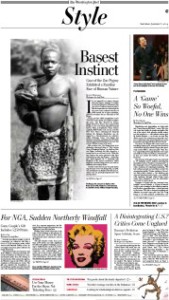 Basest Instinct
Basest Instinct
by Ann Hornaday
The Washington Post, p. C1.
January 3, 2009
It’s not unusual for a minor, obscure historical figure suddenly to bubble up into the zeitgeist. (Remember the year of two Truman Capote movies?) But the inspiration for what might be the most arcane cultural reference of 2008 turned out to have particular, grievous resonance for me. His name is Ota Benga. If you saw the wildly imaginative movie “The Fall” in the spring, you might recognize the name. The film, directed by Tarsem Singh, featured a former slave named Otta Benga as one of its larger-than-life fictional heroes. Then, in September, Texas venture capitalist Bill Perkins took out an ad in the New York Times criticizing the financial bailout; the full-page illustration was designed by a Houston-based art collective called Otabenga Jones. Ota Benga has inspired musicians, including the Brooklyn experimental band Piñataland. Someone has set up a MySpace page in his name.
But nowhere has Ota Benga been more obviously referenced than in “The Curious Case of Benjamin Button,” in which an African Pygmy befriends the title character, a young man in an old man’s body. While the two explore the racier pleasures that New Orleans has to offer, the Pygmy — in the film he’s called Ngunda Oti — cheerfully tells Benjamin of his various adventures, which happen to include being put in a zoo and exhibited in the monkey house.

